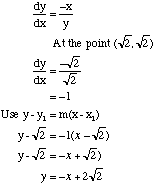|
By differentiating and finding the derived or gradient function we obtain an equation which will give the gradient at any point on the curve. The gradient for a particular value of x can then be obtained by substitution. Finding the Equation of the Tangent to a CurveOnce the gradient of a tangent to a curve has been found, the formula y − y1 = m(x − x1) can be used to find the equation of the tangent at the point (x1, y1). Example There are two methods for solving this problem.
Finding the Equation of the Normal to a CurveThe normal to a tangent to a curve at a point is the line perpendicular to the tangent at the point of contact. If a line with gradient m1 is perpendicular to another line with gradient m2 then m1 x m2 = -1. ⇒ m1 = -1/ m2 Example Find the equation of the normal to the curve x2 + y2 = 4 at the point (√2, √2) The two methods shown above can be used to find that the gradient of the tangent at (√2, √2) is m = -1 The gradient of the normal is m = -1/ -1 = 1 Hence the equation is:
|
